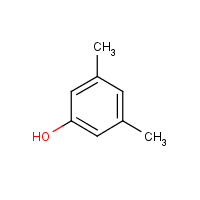3,5-Dimethylphenol
Agent Name
3,5-Dimethylphenol
Alternative Name
3,5-Xylenol
CAS Number
108-68-9
Formula
C8-H10-O
Major Category
Other Classes

Synonyms
1,3,5-Xylenol; 1-Hydroxy-3,5-dimethylbenzene; 3,5-DMP; Benzene, 1,3-dimethyl-5-hydroxy-; Phenol, 3,5-dimethyl-; sym-m-Xylenol; Xylenol 200; [ChemIDplus] UN2261
Category
Phenols
Description
White to yellow solid; [ICSC] Hygroscopic; [CAMEO] Yellow crystalline solid; [MSDSonline]
Sources/Uses
Used as a chemical intermediate for biocides, antioxidants, pharmaceuticals, herbicides, phenolic resins, Metaxalone (muscle relaxant), and methyl carbamate derivatives for insecticides; [HSDB]
Comments
Causes ataxia and muscle contraction/spasticity in lethal-dose testing of mice; [RTECS] Toxic by ingestion; A severe eye irritant; [HSDB] A corrosive substance that can cause injury to the skin and eyes; A respiratory tract irritant; [ICSC] A corrosive substance that can cause injury to the skin, eyes, and respiratory tract; Inhalation may cause chemical pneumonitis; May be absorbed through skin; [MSDSonline] "As the six dimethylphenol isomers and the mixed isomer substance are generally similar in toxicity, a common TLV for these substances is appropriate. . . . In mice, oral exposure to 250 mg/kg/day produced changes in blood parameters including statistically significant decreases in mean corpuscular volume and mean corpuscular hemoglobin concentration (4 and 3% reduction in mean values, respectively. . . . Available data on skin sensitization from exposure to dimethylphenol are mixed but warrant the addition of a DSEN notation. . . . All six dimethylphenol isomers were tested in a mouse local lymph node assay and the results found 2.4, 2,5, and 3,4-dimethylphenol to be positive for skin sensitization." There are no epidemiology studies. In a case report, ingestion of about 250 ml of a mixture of dimethylphenol isomers resulted in CNS depression, hypotension, and death. [ACGIH] See "Phenol."
Biomedical References
Exposure Assessment
TLV (ACGIH)
1 ppm, inhalable fraction and vapor
Vapor Pressure
0.0405 mm Hg
Lethal Concentration
LC (rat) > 4 mg/m3
Explanatory Notes
Odor threshold = 4.10E-5 mg/m3 (detection in air); [HSDB] Flash point = 80 deg C; [ICSC] The Guide in the Emergency Response Guidebook is for "Xylenols, solid."
Adverse Effects
Toxic Pneumonitis
Yes
Neurotoxin
Other CNS neurotoxin
Dermatotoxin
Skin burns
ACGIH Carcinogen
Confirmed Animal
Diseases, Processes, and Activities Linked to This Agent
Other Information
No other related information on this agent was found.